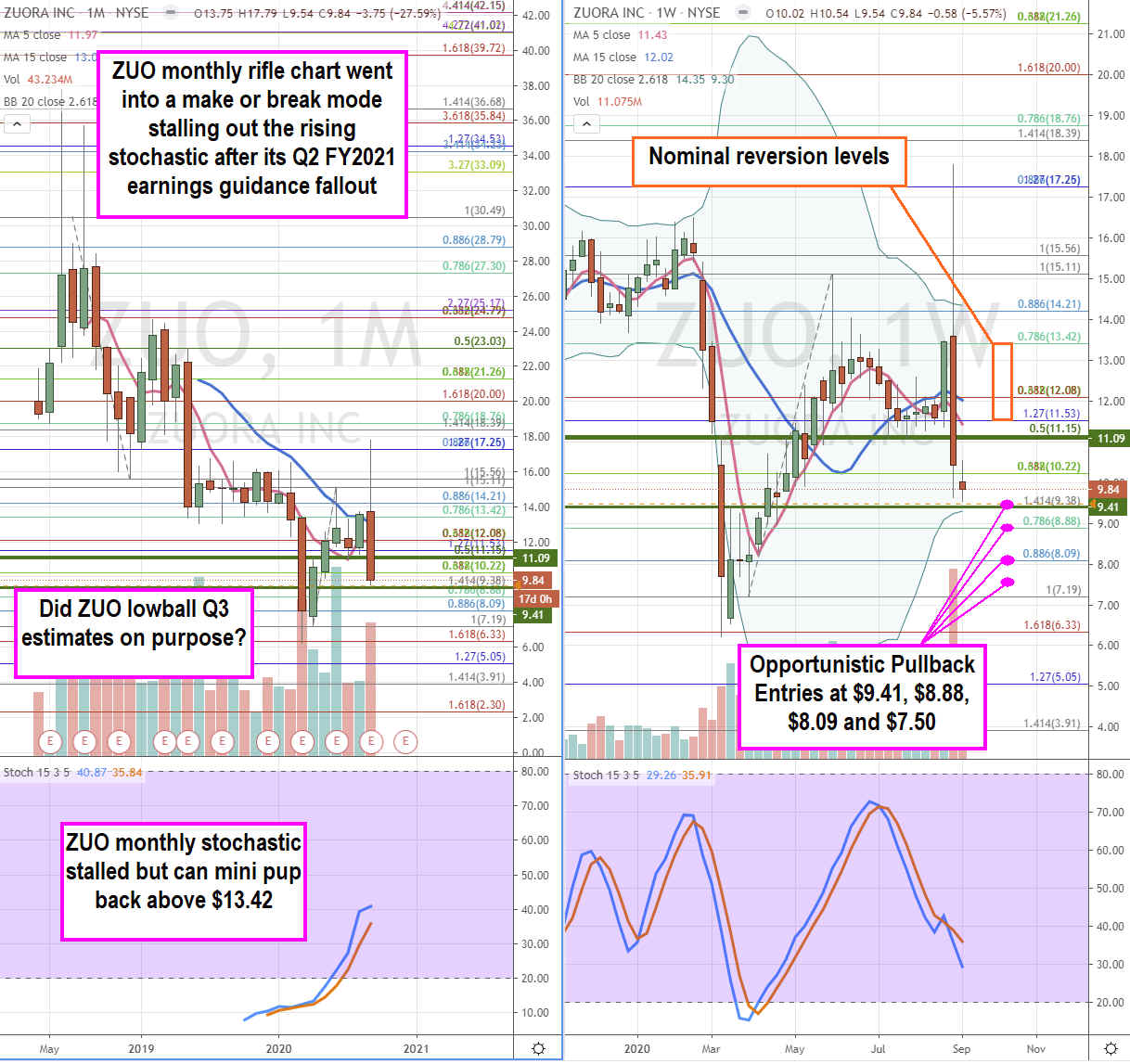Cloud-based subscription billing platform
Zuora. Inc. NASDAQ: ZUO shares literally imploded on its recent Q2 2020 earnings release plunging shares back under its February pre-COVID highs and severely underperforming the benchmark
S&P 500 index NYSEARCA: SPY. As the dust clears, prudent investors should delve deeper into the growth of subscription-based business trends. Zuora provides a one-stop solution for converting products and services into a cash flow engine through their integrated cloud-based platform. Shares were punished dramatically on its Q3 guidance figures. However, the Company may be lowballing expectations, which turns the panic-driven selling into bargain entry opportunities for astute investors.
Q2 FY 2021 Earnings Release
On Sept. 2, 2020, Quora released its second-quarter fiscal 2021 results for the quarter ending July 2020. TheCompany reported earnings-per-share (EPS) profit of $0.07 excluding non-recurring items beating consensus analyst estimates for breakeven by $0.07 EPS. Revenues grew 7.5% year-over-year (YoY) to $75 million beating consensus estimates of $73.47 million. Investors were clearly disappointed as subscription revenue growth slowed to 15% from 20% YoY and total revenue growth fell to 7.5% from 15% YoY in Q2 FY 2021. This reflects a drop in customer retention rate for 112% to 99% YoY. The CEO Tien Tzuo noted that the decline was due to product fit and customer consolidation through acquisitions. Margins improved to 55% from 51% due to expense controls in reaction to COVID-19. The bearish sentiment was further magnified with its lackluster guidance. The Company lowered forward guidance for Q3 FY 2021 for an EPS loss of (-$0.05) to (-$0.04) versus consensus estimates of (-$0.05) and revenues of $73 million to $75 million versus $75.5 million. Full-year FY 2021 guidance was pulled due to COVID-19 impacts on transparency. The Company expects to be free cash flow neutral by Q4 2021.
COVID-19 Effect
The Company was able to take 41 customer live in the quarter despite the pandemic. Zuora outlined how their Subscription Economy Index Report indicated how S&P 500 saw revenues contract at an average of 10% during the pandemic, while Zuora’s subscription-based companies in the report expanded 12%. The subscription-based business model is the future. COVID-19 has generated more headwinds underscoring the agility of its platform. Subscription All-Star clients including Zoom Video NASDAQ: ZM, DocuSign NASDAQ: DOCU and Honeywell NYSE: HON have leveraged their growth with the agility provided by its platform. COVID-19 has caused companies to scramble and adapt in unprecedented manners quickly. CEO Tzuo stated that with their services, “Customers are able to quickly spin-up new services, capture new demand and react to the market in days, not months.” Another example was how Australian client Foxtel accelerated the launch of content streaming service Binge in May 2020 growing to over 185,000 subscribers thanks to Zuora Billing and Revenue systems which are scalable due to automation and predictive analytics. The Company gained 35 new customers for the quarter, but COVID-19 effects resulted in client loss due to business failures, bankruptcies and M&A. As businesses recover or shift to subscription-based models, Zuora should recover with the restart narrative.
Salesforce.com Origins
Salesforce CEO Mark Benioff was an early seed investor with 2.7% ownership of the Company. Zuora Founder and CEO Tien Tzuo was the 11th employee of Salesforce. Zuora is arguably the leader in its niche of automated subscription billing platforms engineered to handle complex relationships. Salesforce CPQ NYSE: CRM is not as agile as Zuora CPQ, which is why they are fully integrated with Salesforce. Zuora would galvanize Salesforce’s shortfalls in that segment. As ZUO shares get cheaper, the speculation of an acquisition stirs up.
Lowballing on Purpose?
The subscription model has proven to be successful, just take a look at Microsoft Office 360 NASDAQ: MSFT or Adobe Creative Suite NASDAQ: ADBE as they turned their costly software programs into subscription services. This brings into question as to whether the Company is purposely low-balling estimates setting the bar low for Q3. Prudent investors with a long-term focus on an economy recovery narrative may consider taking positions at the opportunistic price levels heading into Q3 as expectations have clearly been set low.

ZUO Opportunistic Price Levels
Using the rifle charts on the monthly and weekly time frames provides a broader view of the landscape for ZUO stock. The monthly rifle chart triggered a market structure low (MSL) buy trigger above $11.09 and weekly MSL triggered above $9.41. The recent price implosion on reaction to Q3 guidance has caused the monthly stochastic oscillation up to flatten as the downtrend resumed on the breakdown through the monthly 5-period moving average (MA) at $11.97. The weekly stochastic was slapped back down forming a bearish pretzel mini inverse pup targeting lower Bollinger Bands (BBs) overlapping the $9.38 Fibonacci (fib) level. The selling is providing opportunistic pullback levels at the $9.41 weekly MSL trigger and overlapping fib, $8.88 fib, $8.09 fib and $7.50 stinky 2.50s zone. Upside reversions towards the monthly 5-period MA and 15-period MA sit at $12.08 and $13.42 targets.
Learn the basics of options trading and how to use them to boost returns and manage risk with this free report from MarketBeat. Click the link below to get your free copy.
Get This Free Report
Like this article? Share it with a colleague.
Link copied to clipboard.